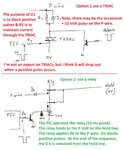ljcox
Full Member level 5
- Joined
- Feb 1, 2006
- Messages
- 252
- Helped
- 25
- Reputation
- 50
- Reaction score
- 23
- Trophy points
- 1,298
- Location
- Melbourne Australia
- Activity points
- 3,110
I need relays with the following specifications:-
A coil voltage in the range 5 Volt to 48 Volt.
Contacts - either DPST or DPDT able to switch at least 60 Volt DC and a current rating of at least 500 mA.
I prefer SMD mounting but through the hole will suffice if SMD relays with the above specifications are not available.
Does any one know where I can purchase such relays? I need 80, so the price is critical.
I tried RS Components & Element 14, but they have little to offer.
I also did a search of Chinese companies but found their web sites frustrating. The ones I viewed did not have a sensible search engine. Besides, I have the feeling they don't want enquiries from the likes of me.
Any assistance will be appreciated.
Len
A coil voltage in the range 5 Volt to 48 Volt.
Contacts - either DPST or DPDT able to switch at least 60 Volt DC and a current rating of at least 500 mA.
I prefer SMD mounting but through the hole will suffice if SMD relays with the above specifications are not available.
Does any one know where I can purchase such relays? I need 80, so the price is critical.
I tried RS Components & Element 14, but they have little to offer.
I also did a search of Chinese companies but found their web sites frustrating. The ones I viewed did not have a sensible search engine. Besides, I have the feeling they don't want enquiries from the likes of me.
Any assistance will be appreciated.
Len

